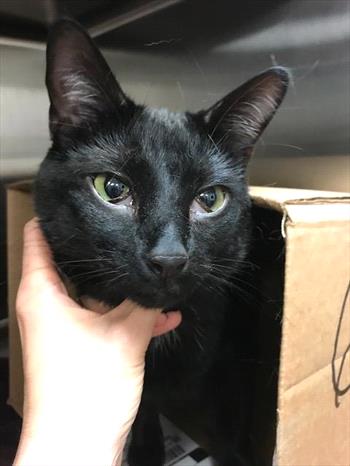Haw Syndrome, Cat (Photograph)

This cat presented initially with the elevated third eyelids, and later developed gastrointestinal signs. The prolapsed third eyelids resolved when the digestive signs resolved. Courtesy Dr. Kate McGowan.
Haws syndrome is an elevation of the third eyelid in both eyes. The third eyelid, or nictitating membrane, is a transparent eyelid some animals have that moistens and covers the eye for protection. In Latin, nictare is to blink. Haw is what the third eyelid in horses are called, although in cats it’s a nictitating membrane. Haws syndrome is not associated with diseases inside or outside of the eyeball, nor the socket. It is also called bilateral third eyelid protrusion, bilateral prolapse of the third eyelid, and bilateral prolapse of the nictitating membrane.
The condition has not been reported in dogs.
The cause is not known. However, the condition is frequently associated with gastrointestinal (GI) inflammatory disorders. The elevation of the third eyelid may be due to a change in the way nerves are supplied to the third eyelid.
A cat's vision is normal with this condition, but may be functionally decreased simply because the elevated third eyelids are blocking the cat's vision. Affected cats may have watery diarrhea that began before the onset of elevation.
Diagnosis
Diagnosis is primarily made on finding classic clinical signs and eliminating other diseases with a thorough ophthalmic and physical examination. The main sign is a protrusion of both third eyelids. Thankfully, the eyes are not painful.
Your veterinarian may do a phenylephrine challenge. Phenylephrine eye drops are applied to the eyeballs to see if the third eyelids return to their normal position within 20 minutes; If they do, then Haws can be confirmed.
Treatment
This condition is usually self-limiting, so no specific treatment is necessary.
Any diarrhea a cat has should be treated as that may be a contributing factor.
Monitoring and Prognosis
The prognosis is good because the condition is often self-limiting. In one report about cats, the average time for the third eyelids to return to normal was 47 days; however, the number of cases evaluated was limited. In a separate report, 17 out of 45 cats had a third eyelid protrusion that persisted for more than 4 weeks. If the condition persists, your veterinarian may suggest further diagnostic tests, especially if your cat has GI signs.